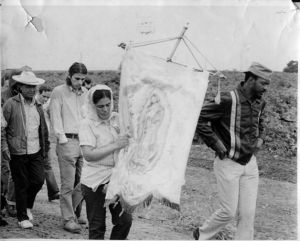The image of the Virgin of Guadalupe has been used to give hope to marginalized people, instill a sense of cultural identity in others and encourage communities to fight for their human rights. December marked the feast day of Our Lady of Guadalupe. Judging from the works on display around Los Angeles, artists are still get inspired from this nearly 500-year-old Catholic icon.
by Lydia Breen
George Yepes has been painting the Virgin of Guadalupe in one form or another all his life. His fasciantion started as a little boy when a painting of the Virgin inside his East Los Angeles church had him hooked.
His most recent work, Virgen de Guadalupe, (shown above) was on display at the Mexican Cultural Institute’s exhibit, Tepeyac Apparitions: La Virgen Revealed. Yepes’ Virgen is proud and defiant, reminiscent of his painting, Adelita, featured in the Autry Museum’s exhibit, “Bold Caballeros y Noble Bandidas”. [“Adelita” is the name given to women soldier/bandits who fought in the the Mexican Revolution.]
José Guadalupe Posada, an illustrator and political commentator, also used the image of the Virgin to rally populist sentiments during the Mexican Revolution.

"Si, se puede" Farmworkers hold a banner with the image of the Virgin of Guadalupe Credit: Reuther Library, Wayne State Univ.
The school’s principal justified the ban as a precautionary measure against gang violence, but it reflects race and class misunderstandings that exist in many communities today.
His recent Virgen doesn’t shy away from exploring the sensual side to this iconic figure. He leaves it up to us to decide what moment in the life of Mary he is portraying:
“Is it when she learns she is with child? Or when she sees her son suffering on the cross. Perhaps she is carrying the pain of her people – or the pain of mothers whose children are in distress.”







how much would you sell this painting of the virgen. I love it. It is so beautiful!
Hi Olivia: Try writing to george@georgeyepes.com
thanks for checking my blog!